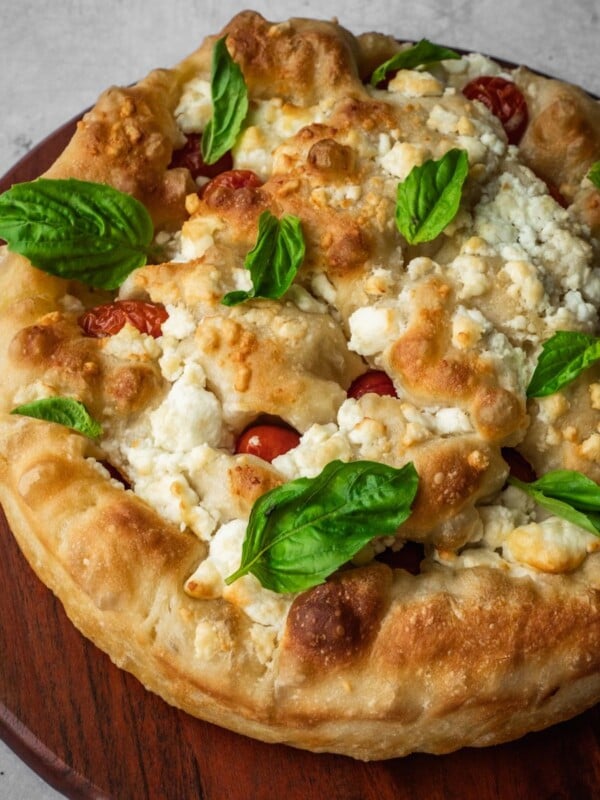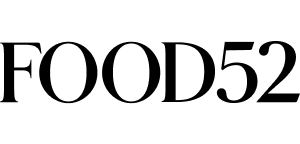Turkish pide bread, or ramazan pidesi, is a traditional Turkish bread made with yeast that’s typically served for iftar and sahur during Ramadan, but can be enjoyed year-round. This soft, round bread is topped with sesame seeds and features a distinctive basket-weave pattern on the top.
Featured in my 35 Ramadan Recipes list, the base bread needs just 5 ingredients, plus the glaze and seed topping. This is a super simple recipe, ready in less than two hours, and is often sold by street vendors in Turkey. Much like pita, try serving with dishes like Mutabal, Cilbir, Mercimek Corbasi (red lentil soup), and Galayet Bandora.

Table of Contents
Ingredients
With less than 10 total ingredients including the glaze, this is an easy flatbread, made with common pantry ingredients.

- Flour: use up to 50% bread flour in place of all-purpose for a stretchier, slightly chewier bread. Up to 50% whole wheat flour can be used as well but the bread will be less light and fluffy.
- Seeds: if you don’t have both colors of sesame seeds, use one or the other. Some nigella seeds can be added too if you like the flavor. Nigella seeds are used in Levantine recipes like Cheese Manakish. Also make sure to try my Turkish Sesame Bread (Simit) recipe.
- Yeast: it has to be instant yeast as it’s added with the dry ingredients. If you want to use traditional yeast, you’ll have to bloom it in the warm milk first and the pide will take longer to rise.
See the recipe card for full information on ingredients and quantities.
Step by Step
The method here is similar to most bread in the mixing process, and shaping is easy and straightforward. Read through and look at the pictures to get a clear idea of how to make the pattern on top.

1. Mix: combine the dry ingredients in the bowl of a stand mixer, then add the warm milk (Images 1a and 1b). Knead with the dough hook for 4-5 minutes, or until smooth (Image 1c).
2. Rise: brush the dough with olive oil and set aside to rise, covered, for about an hour (Image 1d).

3. Flatten: shape the loaf by flattening with your hands into a circle about 3/4″ thick and 12″ in diameter (Image 3).
4. Make indentations: using your fingers, make indentations in the dough about 1″ from the edge of the dough, forming a circle (Image 4).
5. Make the pattern: using your fingers again, make indentations in straight lines, about 2″ apart, in two different directions to form a repeating diamond pattern (Image 5).
6. Glaze: brush the egg yolk and milk all over the surface of the dough, then top with sesame seeds (Image 6).

7. Second rise: set aside to rise for another 15 minutes, then press into the pattern again with your fingertips to make sure it’s defined (Image 7).
8. Bake: bake the pide for 18-20 minutes, or until golden. Cool for a few minutes before serving (Image 8).
Storage, Freezing, and Make Ahead
Storage: keep the bread in a sealed container at room temperature for a couple of days, or refrigerate for up to a week. To refresh it, spritz with a little water and reheat in a warm oven for about 5 minutes.
Freezing: freeze Ramadan pide in an airtight container or resealable bag for up to three months. Thaw as usual and reheat using the method above.
Make Ahead: after the first rise, form ball(s) of dough as outlined in the recipe. Place in a sealed container and refrigerate for up to 24 hours. Let the dough come back up to room temperature before shaping and baking as instructed.
Expert Tips
- Make two: the recipe as pictured mades one large pide, but the dough can be divided and formed into two smaller breads if preferred. Reduce the baking time as needed.
- Use a pizza stone: if you’re comfortable using a pizza stone and peel, that’s a great option for this. Preheat the stone in the oven as usual, and bake the bread on it for 16-18 minutes, or until golden. A pizza stone can also be used to make Lebanese Pita bread.
- Redo the pattern: just before baking, it’s a good idea to go over the diamond pattern with your fingers one more time to make sure it’s defined – think focaccia.
- Knead for longer: if kneading by hand, the time required will be a little longer, more like 8-10 minutes for a smooth, silky dough.
- Heat the milk: this will make the dough rise more quickly, even if your kitchen is on the cold side. Make sure it’s warm, not hot, as too-hot milk will kill the yeast. It should be just warm to the touch.


Recipe FAQs
These are two different names for similar breads in different parts of the Levant region. Pide is specifically Turkish and pita or pitta is common all across the Levant and Middle East.
You can eat it as you would any other flatbread, but it’s excellent with Turkish eggs, labneh balls, bread dipping oil or a main dish like za’atar chicken.
Black sesame seeds have an intact outer layer, which the white seeds don’t. The taste is almost identical, but having both colors makes for a more attractive bread.
More Baking Recipes
If you make this Turkish Pide Bread or any other baking recipes on Urban Farm and Kitchen, please take a moment to rate the recipe ⭐⭐⭐⭐⭐ and leave a comment below. It’s such a help to others who want to try the recipe.
For more Urban Farm and Kitchen, follow along on Instagram, Facebook, and Pinterest, visit the Urban Farm Shop, or subscribe for new posts via email.
Turkish Pide Bread (Ramazan Pidesi)

Equipment
- Stand Mixer – Optional
Ingredients
- 3 ½ cups All-purpose flour – 490 grams
- 2 ¼ tsp Instant yeast – One packet
- 2 tsp White sugar
- 2 tsp Kosher salt
- 1 ⅓ cups Milk – Whole or 2%
- Olive oil for brushing
Glaze and Garnish
- 1 Egg yolk
- 1 tbsp Milk or yogurt
- Sesame seeds for garnish
Instructions
- Mix. In a stand mixer bowl, add the flour, yeast, sugar and salt. Mix to combine. Add the warmed milk. Knead the dough using the dough hook for 4-5 minutes, until you have a nice and supple dough. Alternatively, you can mix the dough in a large bowl and finish kneading it on the counter.
- Rise. Bush the dough ball and bowl with olive oil and cover with a tea towel. Let the dough rise for 1 hour. If your kitchen is on the cool side, you may need to let the dough rise for 1-2 hours.
- Flatten. Preheat the oven to 400F. Transfer the dough ball to a lightly floured piece of parchment paper. Using your hands press down to form a circle that is 3/4" thick. The circle should be about 12" in diameter. Transfer to a baking sheet.
- Circular indentations. Using your fingers, make indentations in the dough about 1" from the edge. You want to create a circular dimpled pattern.
- Diagonal indentations. Once the circle is complete, move onto the diagonals. Using your fingers, make indentations in straight lines, about 1"-2" apart, in two different directions so you end up with a diamond pattern.
- Brush. Make the glaze by mixing the egg yolk and milk (or yogurt) in a small bowl. Using a pastry brush, glaze the entire surface of the pide. Sprinkle sesame seeds all over the pide. You can get creative here if you wish.
- Short second rise: Let the pide rise for another 15 minutes and then go over the dimples once more to ensure you get a nice and defined pattern once baked.
- Bake: Bake the pide in the pre-heated oven for 18-20 minutes. The top will be nice and golden. The bottom should also have some color. Let the bread cool slightly before enjoying.
Video
Notes
- Flour: use up to 50% bread flour instead of all-purpose for a stretchier, slightly chewier bread. Up to 50% whole wheat flour can be used as well but the bread will be less light and fluffy, and you may need to add a little more liquid to get the dough to form a ball.
- Seeds: if you don’t have both colors of sesame seeds, use one or the other. Some nigella seeds can be added too if you like the flavor.
- Yeast: it has to be instant yeast as it’s added with the dry ingredients. If you want to use traditional yeast, you’ll have to bloom it in the warm milk first and the pide will take longer to rise.
Nutrition
Nutrition information is automatically calculated, so should only be used as an approximation.
 Like this recipe? Rate & comment below!
Like this recipe? Rate & comment below!















Hello Salaams Luay! Thank you for the excellent recipe. I followed it and let the bread machine knead and rise the dough. Everything came out so nicely I can’t believe I did it myself:)
Just 1 comment: the bottom of the bread was completely white, it was cooked but white. I had the bread in the middle of the oven with a pan of water on the lowest rack. The top was really nice and brown and had risen beautifully. The inside was soft and fluffy.
Any tips to get the bottom more brown baked?
Thanks
It’s important to make sure the oven is fully preheated. A metal baking sheet/tray also helps ensure the brown bottom. The only thing that may have interfered is your pan of water. Perhaps it was blocking the heating element from radiating heat to the bottom of the baking sheet. You don’t need that for this recipe in my opinion.